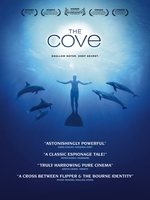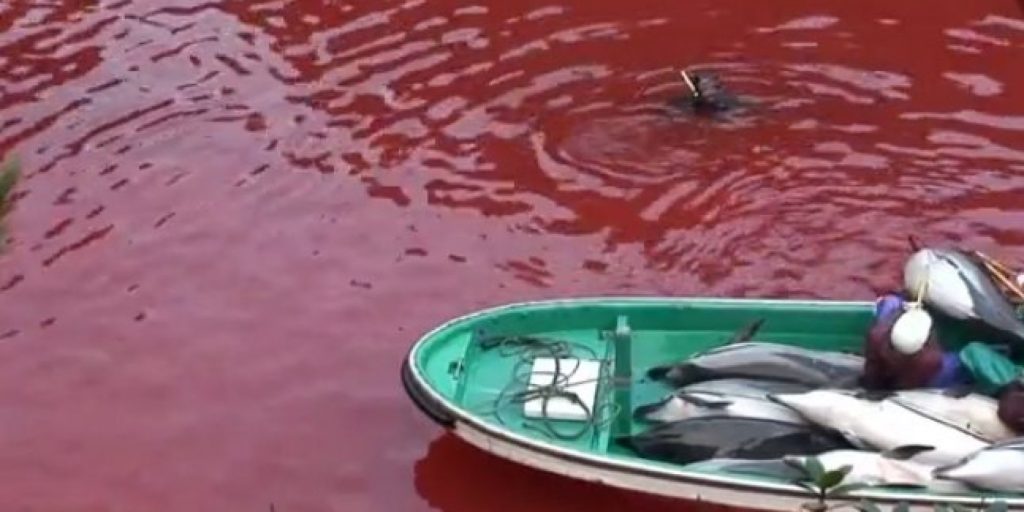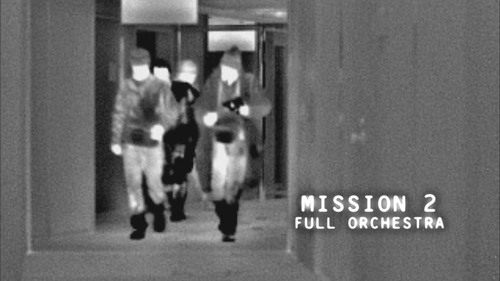
Academy Award winning The Cove (2009) is a documentary film that follows a group of activists, led by renowned dolphin trainer Ric O’Barry, on their mission to expose the mistreatment of dolphins and porpoises in Taiji, Japan. The documentary tells of O’Barry’s own complex relationship with cetaceans, with The Cove exploring and attempting to justify his decision to fight against keeping these animals in captivity after his own career was carved from capturing and becoming the trainer to five dolphins on NBC’s Flipper (1963-1967). The film follows the recruitment of a ‘team’ who become as devoted to the treatment of dolphins as O’Barry himself, documenting their mission to penetrate Taiji’s corrupted high security cove, in which 23,000 dolphins are alleged to be brutally slaughtered each year.
The Cove is constructed in a documentary style, combining O’Barry’s own personal “voluminous video archive”[1] of his animal activism in the last thirty years with the narrative of their team on a ‘Two Phase Mission’ to obtain footage of the harrowing events that occur at the Japanese cove. An interesting element of The Cove is its reversal of the “fly-on-the-wall approach”[2] that is commonly used throughout the documentary genre. Whilst this approach is often used to “bring the intimate lives of animals closer to humans, […] reducing the perceived distance between animals and humans”[3], the ‘team’s’ cameras are planted in such a style that does not award all attention to the dolphins, but also puts the hunters of Taiji that viciously attack the dolphins under The Cove’s sharp glare. The “fly-on-the-wall approach” is used eerily at 76.20, as we observe the hunters in grotesque conversation about cetacean slaughter. Here, it is as though we are observing the true animals of the film, probing the hunters’ bestial secret, with this scene becoming antithetical to the intimate and soothing clips shown of dolphins in their natural habitat, albeit amongst compassionate divers. However, there are suggestions laid out by Psihoyos that encourage viewers to recognise elements of the action genre; with a dramatically emotive soundtrack and extensive use of thermal camera footage implying that their team are quite literally on a ‘Two Phase Mission’.

The intricate structure of The Cove encourages viewers to realise that this film has been created by and features a team who are dogmatic in their belief that the way in which dolphins and porpoises are being treated in Taiji is highly immoral. Not only are O’Barry’s team against the slaughtering of dolphins, but also the plucking out of dolphins to become Japan’s next star performer. The implication that dolphins and porpoises should remain undisturbed in the ocean is made clear beyond the interviews given by those who argue against captivity, as it becomes a motif throughout The Cove that whenever we are shown footage of dolphins swimming freely in open water, there is an abundance of free space in shot. Typically, Psihoyos does not let one dolphin dominate the shot; its natural surroundings take up much of the frame, thus exaggerating the notion of a dolphin’s freedom when in its birthplace. When these scenic shots are combined with contrastingly gentle music with no lyrics and the predominance of the ocean’s piercing blue, it becomes unequivocal that this is the most safe and enjoyable place for dolphins and porpoises to reside. The noticeable fluidity of these clips also do not offer a “fly-on-the-wall” approach; instead allowing viewers to ostensibly travel the ocean amongst the dolphins, whereas we observe the hunters in Taiji with much more distance between us. These cinematic shots purposely juxtapose clips that show dolphins within close proximity of each other, so when either held in captivity or driven to the cove. For example, claustrophobically zooming in on sick dolphins in performing tanks does nothing but encourage viewers to invest in Psihoyos’s suggestion that open water is the only environment suitable for dolphins. This contrast is depicted further by swift scene cuts to clips of SeaWorld, in which the cameras pan quickly in an attempt to capture every trick the cetaceans perform whilst contrastingly loud and belligerent music is blared.
A common trait of the documentary genre is its use of flashback to divulge earlier anecdotes or events to viewers; The Cove displays flashbacks from O’Barry’s own “voluminous video archive”[4] in an attempt to get empathy from the viewers for both the dolphins and himself. The style that O’Barry and other ‘characters’ such as Psihoyos recall events is a first example of flashback, with O’Barry discussing his demise as a dolphin trainer to make way for him becoming a self-proclaimed activist. Yet his narrative is highlighted visually, through slow zoom-ins on old photographs of O’Barry with dolphins such as Cathy, one of the dolphins who portrayed Flipper, and through personal footage of him embarking upon his career as an activist. Clips of a British News report at 52.01 expand on protests based in London following O’Barry’s influence upon animal rights, thus it is suggested that his project is building momentum. This sense of progression is exaggerated through O’Barry’s “video archive” that depicts him as orchestrating a one man project, to a cinematically advanced piece of work that protests against cruelty to dolphins. Handheld underwater cameras are used to capture O’Barry plunging alone into water to cut materials being used to entrap dolphins. The handheld nature of the shot is amateur in comparison to the complex cameras used by the team in The Cove, with Psihoyos’ recruitment of military grade thermal and concealed on-body cameras to capture this new, exciting and secretive mission.

Whilst The Cove is a cinematic documentation of real events, with features such as captions and character follow-ups appearing in the film, parts of the film are stylised to act as pastiche to the action genre. The montage of footage that acts as a backdrop to the film’s opening credits consists of clips from thermal cameras and have been filmed with night vision in use; the eerie black and white imagery reminiscent of military styled film. Following Psihoyos’s declaration that “We need to get down there and film exactly what happens”, thus establishing an aim, at 33.04 he discusses the self-proclaimed “Ocean’s Eleven team” and the fact they were about to embark upon “kinda, like, a rock concert”. Infused with an intensifying non-diegetic soundtrack, the buzz of the ‘team’s’ “Two Phase Mission” panders to generic elements of an action film. We are therefore aligned with O’Barry and his team, leaving those who oppose the welfare of dolphins to assume their roles as antagonists.
This documentary film and all of the work that O’Barry has carried out concerning the protection of dolphins and porpoises undoubtedly places not only these animals on a pedestal, but arguably defames those responsible for these acts of slaughter to such an extent that we cannot align them alongside ourselves as humans. Psihoyos and O’Barry do not offer any justifications for the Japanese behaviour towards cetaceans, other than a hunger for monetary profit. The “fly-on-the-wall” style of filming does not “reduce the perceived distance”[5] between the subject and viewer, but merely caricatures the Japanese hunters into monstrous forms of humanity. We are fed information that does nothing but strengthen our empathy for these dolphins that suffer, with The Cove awarding more worth to the dolphins than to those who slaughter them. Moreover, the portrayal of this slaughter adopts tropes leant from the horror genre, presenting the dolphins as the victims of brutal behaviour. The Flipper theme song becomes a motif throughout the documentary; yet each time the track is repeated it is distorted and played much slower than its original style, contributing to an eerie ambience set by Psihoyos. The final slaughter scene also acknowledges the horror genre at 76.57 when the underwater camera captures a flood of blood surge from the dolphins. It is the diegetic sound that haunts its audience, rather than climatic music added, as the unnerving sounds of the wind and the dolphins’ squeals contribute to the film’s sense of injustice.
Whilst O’Barry’s passion against marine captivity aligns The Cove with documentary films like Blackfish (2013), many dissimilarities can be noted between the two films. There is a great sense of human presence throughout The Cove, from touching upon the argued corruption of Japanese government to emotional dialogues offered from O’Barry, which unconventionally allows these non-fictitious characters to adopt character archetypes as laid out by Vladimir Propp; with O’Barry and co. becoming the “Hero”,[6] the hunters becoming “Villains”[7] and the dolphins adopting the role of “Princesses”.[8] Perhaps the merging of genre conventions, such as action and horror with documentary, dilutes the concept of a documentary as an educational text. Perhaps the comparison between The Cove and Grizzly Man (2005) is more plausible; with the exploration of Timothy Treadwell’s obsession with bears leading him into an action filled lifestyle that tragically led him to his death. O’Barry constantly reminds viewers that “If they could kill me, they would” – but here references the Japanese hunters, rather than any form of animal.BIBLIOGRAPHY:
[1] An Anguished Self-Subjection: Man and Animal in Werner Herzog’s ‘Grizzly Man’ by Stefan Mattessich, ESC., 39.1 (2013), 51 – 70, (p. 54)
[2] Animals and Modern Cultures: A Sociology of Human-Animal Relations in Modernity by Adrian Franklin (London: SAGE Publications, 1999) p. 48
[3] Animals and Modern Cultures: A Sociology of Human-Animal Relations in Modernity by Adrian Franklin (London: SAGE Publications, 1999) p. 48
[4] An Anguished Self-Subjection: Man and Animal in Werner Herzog’s ‘Grizzly Man’ by Stefan Mattessich, ESC., 39.1 (2013), 50 – 70 (p. 54)
[5] Animals and Modern Cultures: A Sociology of Human-Animal Relations in Modernity by Adrian Franklin (London: SAGE Publications, 1999) p. 48
[6] ‘Folklore and Reality’, Theory and History of Folklore by Vladimir Propp (Manchester: Manchester University Press, 1984) p. 28
[7] ‘Transformations of the Wondertale’, Theory and History of Folklore by Vladimir Propp (Manchester: Manchester University Press, 1984) p. 97
[8] ‘Ritual Laughter in Folklore’, Theory and History of Folklore by Vladimir Propp (Manchester: Manchester University Press, 1984) p. 144